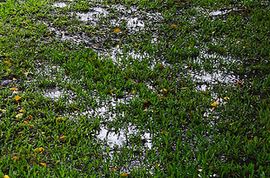For lawns, too much water can be just as damaging as too little. Excess water sitting on the ground prevents oxygen getting to grass’s roots, effectively drowning them. In the short term this can cause turf to turn a sickly, unattractive yellow colour. If the problem persists it can ultimately lead to patches of dead grass which are often quickly overrun by moss. So, if the autumn rain left your lawn looking like a swamp, it’s time to take action.
Getting to the root of the problem
Waterlogging is nearly always caused by poor drainage. This can be down to a number of factors, but the most common are soil that has become compacted or that is rich in heavy clay. This results in a lawn surface which is very dense with little space for water to drain through. The solution to this is to find ways of making your soil lighter which can be achieved is several different ways.
Making holes
One of the quickest and simplest ways to increase the rate at which water drains through your lawn is by piercing the surface with a series of holes. Make these holes deep enough – around 6 inches (15cm) – and this will instantly allow water to drain away from the surface and the roots of your grass. When the lawn is dryer, you can then apply special sand designed for top dressing lawns to the surface and brush it into the holes. Top dressing sand is much lighter than most common soil types so will go a long way to improving your lawns overall drainage. Please note, however, that you should on no account use builders’ sand for top dressing as this will only make your drainage problems worse.
To create the holes you need you can use an ordinary garden fork, although this will compact the soil around the holes even more. The best solution is to buy a hollow-tined fork which will remove small plugs of soil from the lawn which can then be filled with top dressing sand to give better draining and general soil quality.
Starting over
If you are suffering really heavy waterlogging on a regular basis, and especially if your soil is mainly clay, you may need to consider digging up your existing lawn and starting again. If you do decide to go down this route, you will need to dig down around 2-6inches (5-15cm) and put down a bed of sharp sand and good quality top soil on which to lay your new turf or spread your grass seed. This will give you good drainage at the surface and prevent excess water sitting on and around your grass in future.
Top tip – If you need a way to quickly remove standing water from the surface of your lawn without damaging your grass, try brushing it off with a garden broom.
For more advice on how to deal with waterlogging or any other issues you’re having with your lawn, call Proctors today on 0117 311 1217 or feel free to Ask John.
























